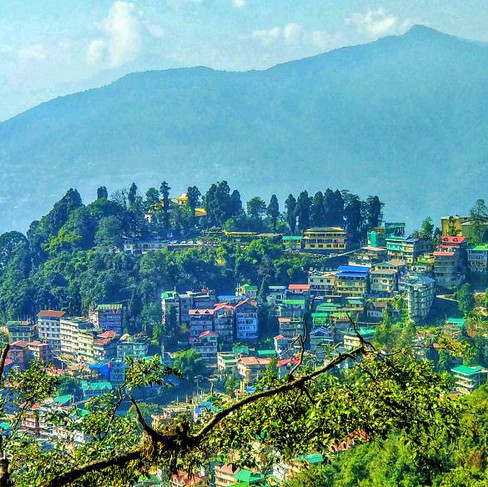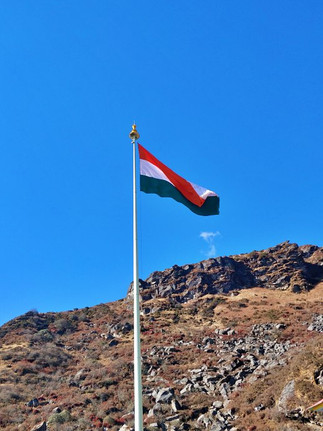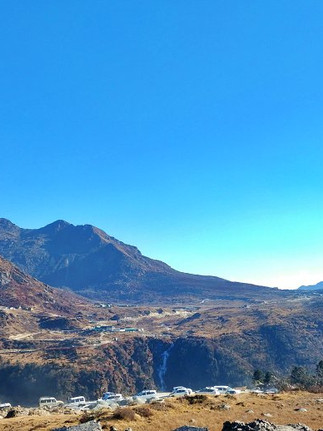Tsomgo Lake, also known as Tsongmo Lake or Changgu Lake, is a glacial lake in the East Sikkim district of the Indian state of Sikkim. Tsomgo Lake is situated around 40 KMs from Gangtok and at an elevation of ~3,800 metres (12,300+ feet) and presents one of the most rugged terrains to drive on! With the enchanting environment and the mesmerising landscape, East Sikkim is indeed a gorgeous destination in Sikkim! And amongst it all, the Sikkim Silk Route tour is one of the most famous destinations.
After having explored the beauty of Gangtok through local sightseeing, it was time to explore the rugged mountainous terrains through a trip to Tsomgo Lake and Baba Mandir. Even though the lake remains frozen in winter, we could still only see a thin sheet of ice forming over the lake (we went at the end of December). The day started early from our homestay in Gangtok & we were on the road post a sumptuous breakfast.
Zuluk (also spelled as Dzuluk) was once an important stop on the Ancient Silk Road. The Ancient Silk Road was actually a huge network of ancient trade routes that stretched from Asia to the Mediterranean traversing China, India, Persia, Arabia, Egypt, Greece and Italy. This route was formally established during the Han Dynasty of China in 130 BC. It linked regions of the ancient world in commerce between the periods of 130 BCE-1453 CE. The Indian part of the Silk Route is open for tourists from Rongli to the Nathula Pass. The region is no doubt historically interesting, but it is the stunning vistas of the route that attracts tourists to this part of East Sikkim. Today Sikkim Silk Route is known for its clear and gorgeous views of the mountains, the dizzying zig-zag roads and hairpin bends and quaint villages on the route.

Places to visit during the day trip to East Sikkim:
Nathula Pass
Baba Mandir
Kupup Lake
Tsomgo Lake
We chose to skip the Nathula Pass as we wanted to spend more time exploring Baba Mandir & Tsomgo Lake that would give us a taste of the rugged roads of the ancient Silk route. However, we do need a vehicle permit for any travel to Nathula Pass, Baba Mandir & Tsomgo Lake which is mostly arranged by the tour operator itself. 2 passport size photos & Government ID proof are required for the vehicle pass. Do note: It is better to email the documents to your tour agency beforehand such that the vehicle pass can be arranged. During the tourist season, this can be major reason of delay in your trip - leaving you with lesser time to spend up top.

Baba Mandir: Baba Harbhajan Singh Mandir (temple) is around 52 kms from Gangtok. The temple is named after an Indian Army soldier who died by slipping and falling into a steep narrow valley. It is believed that he appeared in the dream of one of the soldiers asking him to build a samadhi for him. Currently, all tourists are taken to the New Baba Mandir which was built in 1982 for the convenience of the tourists. The original (old) Baba Mandir is at a distance of 9 kms from the new one for which the driver usually asks for an extra amount.

Baba Mandir was very unique from all the temples built by soldiers that I had seen earlier. The soldiers there believe that the spirit of Baba Harbhajan Singh is still guarding the area. They had an office room and a bed room with all the set up ready for Baba Harbhajan Singh to carry out his every day duty. It is also said that the bed sheets get crumbled and shoes get muddy everyday (not sure how true this is). There was a restroom and café right opposite to the temple. Photography was not allowed inside the temple. The view of the Nathang Valley from the temple was absolutely breath-taking.
Kupup Lake: On a clear day, if a lake manifests emerald blue hues and appears in shape like an elephant, it will be Kupup Lake. At the centerstage of a glorious adjoining valley, a small village Kupup with a sparse population and a police check post is situated on the banks of it. Bitan Cho, as it is locally called is also referred to as Elephant Lake due to its resemblance of shape. This lake is crossed on the way back from Baba Mandir to Tsomgo Lake and does make an interesting sight!
Tsomgo Lake: On the way back from Baba Mandir, a winding, rugged, road with hairpin bands took us to the Tsomgo Lake. Tsomgo means ‘the source of water’ in Bhutia language. Tsomgo Lake is known for its color-changing patterns in every season. In winter the lake is frozen while in spring there is a riot of colors because of the abundant flowers near the lake. The sacred Tsomgo Lake is believed to have healing qualities hence to offer prayers Jhakris (faith healers) congregate every year on Guru Purnima which coincides with Raksha Bandhan as well. We saw the color change in a single day rather in a couple of hours.
According to history, Tsomgo Lake was previously a shed place where Yaks graze and live, and around the shed place, there was a village that belonged to the tribal people. There was an old woman in the tribe when she had a dream one night that very soon the village would be drowned by water leaving no signs of life. She warned the village people to vacate their homes and leave the place but nobody gave any interest and gave her a crazy title. Thus she failed to convince the people of the village and left with her yak in disguise. But one day the village got drowned underwater and no sign of lives could be seen or found. Since then the natives of Sikkim visit Tsomgo Lake to pay tribute to the dead spirit. Surrounded by lush landscapes and alpine forests, the lake bears a mythical history and the localities acclaim it to be a sacred lake. There are sayings that long ago, Buddhist monks could forecast the future by studying the changing colors of the water.
To get a sweeping view of everything, there’s a cable car at Tsomgo Lake that takes you up to a height of 14,500 feet. You are allowed to stay on top of the hill for 10 minutes before you come down again. This is one of the best parts of the trip, with mesmerising views of the mountains & a sharp chill in the air!

You can also enjoy a yak ride around the lake. Mid-May, a variety of flowers including rhododendrons bloom around the periphery of the lake. There is a small temple dedicated to Shiva on the bank of the lake.
As the lake is located in a restricted area, tourists need to obtain permits to visit it.


Things to remember:
Landslides are a common occurrence in Sikkim during rainy seasons.
Border Road Organization (BRO) takes care of the roads and due to the difficult terrain and frequent landslides they have to lay it often.
You will be crossing many areas where army is stationed during your day trip, where photography is strictly prohibited.
Sikkim Government is very strict against littering and it is a punishable offence.
You will have to start early to make sure you reach back Gangtok early. At 3pm, the clouds start covering the mountains. It gets risky to drive down after that.

At the end of the most enthralling but draining trip to Tsomgo Lake, we came back to MG Mark, Gangtok for a good hearty dinner! Post the same, we retired to our homestay & began packing for the next part of our Sikkim trip. Stay tuned for more....
For all budding travel enthusiasts out there, if you need our travel experiences straight into your inbox, do visit our page and subscribe to us. You can also follow us on Instagram and Facebook to get the weekly dose of travel experiences!!
* FIN *

































Comentários